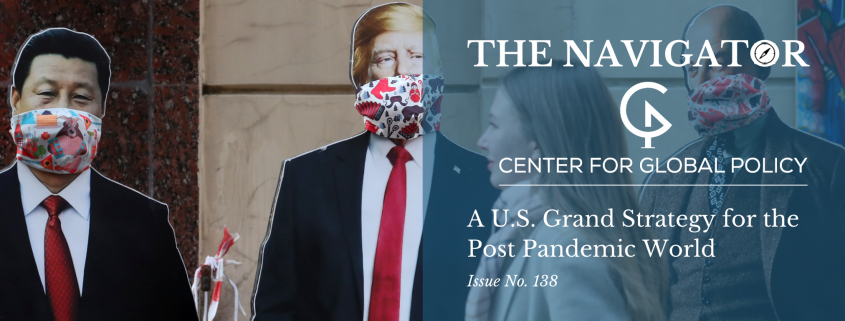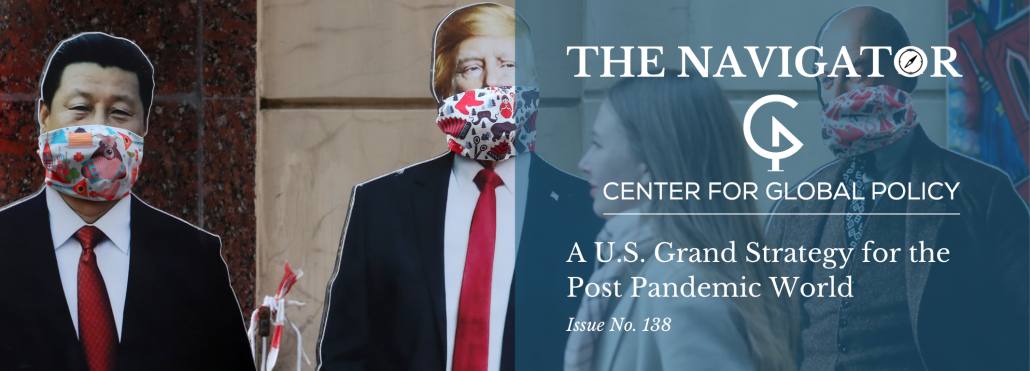A U.S. Grand Strategy for the Post Pandemic World
by Dr. Muqtedar Khan
For the United States, the geopolitics of the COVID-19 pandemic will boil down to a contest with China.
COVID-19 pandemic could transform the world. Many geopolitical experts are concerned that this crisis, more than any other this century, has the potential to permanently reconstitute the global order. Some are even arguing that while the United States is abdicating global leadership during the current pandemic, China is using it to reinforce its growing status as the alternate destination for economic aid, medical and scientific support, and leadership for many nations, including Western and developed nations like Italy. Some commentators claim that China is using the crisis to dethrone the United States as a global superpower.
While it is difficult to predict the overall death toll, socio-political disruption, and the economic impact of the coronavirus pandemic, a few things are already manifest. The main vehicle of COVID-19’s destructive impact will not be through its potentially significant death toll but rather through its economic fallout. There will be a sustained global economic recession that will impact some countries harder than others. All major powers – the United States, China, Europe, and Russia will come out bruised and battered by the pandemic, and in the Middle East, Iran – the only counter-hegemonic player – will be definitely downsized in the economy and state capacity. While the United States’ soft power has declined in the age of Trump, the crisis now tarnishes the larger-than-life images of Xi Jinping of China, Narendra Modi of India, and other populist leaders. Even European nations’ aura of good governance and exemplary healthcare systems has lost its shine. The pandemic is proving to be a great leveler.
The Great Disruption is a Great Opportunity
In this context, there are two scenarios for a U.S. grand strategy. The first will compel the United States to invest in itself, and the second may empower it to reshuffle the deck and rebuild a more U.S.-friendly global order.
U.S. grand strategy progressed from coast to coast continental domination under the doctrine of “manifest destiny,” to hemispheric domination under the Monroe Doctrine and then to global domination under the doctrine of “containment.” After the collapse of the Soviet Union, the United States shifted from containing communism to combating violent extremism and containing nuclear proliferation and regional challenges to U.S. hegemony. Now, Washington faces the global challenge of the economic and military rise of China. The current grand strategy is still a variant of the containment doctrine – global engagement to contain any threat to U.S. preeminence globally, regionally, militarily, and economically.
Currently, the United States has two real challengers: China and Iran. The challenges posed by Russia and North Korea are limited, geographically speaking. The combination of coronavirus pandemic and U.S. sanctions are ravaging Iran’s economy and diminishing the capacity of the Iranian state and its proxies. Iran, henceforth, will remain an irritant but may not be a threat worthy of a grand strategy. This means the epicenter of geopolitical contestation will be confined to a U.S.-China struggle in the Asian theater as well as on the global stage.
U.S.-China Balance of Power and Influence
In 2015, a study by the Council on Foreign Relations concluded that China would be a long-term competitor to the United States’ primacy and called for a more coherent U.S. response to increasing Chinese power. In essence, this study called for an American grand strategy to center on the challenge of China’s growing economic and global influence. The study explicitly claims that China’s grand strategy aimed to replace the United States as the principal power in Asia, and hence the United States must seek to balance China’s rising power rather than assist its ascendance.
The report is Asia-centric and misses the point that China’s Belt and Road Initiative is economic power projection beyond Asia. China ultimately seeks not only to assure its hegemony in Asia, but also to replace the United States on the global stage. It also seeks to replace the model of liberal democracy with capitalist authoritarianism as a desired model of governance through its example. Already we are witnessing the global retreat of democracy as more world leaders aspire to the kind of power wielded by Xi, – including U.S. President Donald Trump, who does not conceal his envy for Xi’s consolidation of power.
Not everyone subscribes to the inevitability of China’s ascendance. Some argue that China may not be able to escape the middle-income trap, while others suggest that the Belt and Road initiative will help China avoid the middle-income trap. I believe it is wiser, in the context of formulating a U.S. grand strategy, to assume that China will escape that trap.
The coronavirus pandemic will certainly alter the balance of economic and soft power for both the United States and China. Either one of two scenarios, discussed in detail below, could occur. In the first, China suffers less than the United States and reduces the gap between the two nations’ capabilities and influence. In the second scenario, the United States suffers less than China and gains the opportunity to rebuild the global order such that it is more amenable to democracy, respectful of U.S. interests, and supportive of Washington’s leadership.
Scenario One: Many economists contend that we are already in a global recession and predict that the United States will see a precipitous fall in GDP growth from 6% up to 24% in the second quarter and 10% subsequently. It could take years to recover from this economic downturn. Given China’s manufacturing strength and potentially huge domestic market, it is possible that China would recover faster than the United States, which is more dependent on the service industry. Healthcare at 18% was the biggest component of U.S. GDP before the coronavirus, and manufacturing was at 11%. This gap will increase. The worst-case scenario is that the U.S. economy will shrink by 24%. In that case, the United States will be forced to be defensive while China recovers faster – there are already indications that Chinese exports are coming back online – and rapidly reduces the existing economic, scientific, and military gap between China and the United States.
The strategic option for Washington, which will be inforced retrenchment mode, is to preserve its soft power sources and rebuild hard power:
- Abstain from expensive adventures abroad, especially in the Middle East.
- Withhold global public goods and force China to foot the bill for the global order from which it benefits, for a change.
- Work more closely with allies in Asia, Europe, and international institutions while simultaneously working hard to put the domestic scene in order.
- Emerge from the debilitating culture of partisanship and focus on nation-building at home on a war footing. This would involve focusing on rebuilding the economy, embracing science once again, instituting immigration reforms to bring in more scientific talent and resources, and strengthen U.S. democracy, which is the key to global legitimacy.
Scenario Two: If the negative forecasts are wrong and the United States emerges from the shadow of the pandemic by the end of summer, Washington will have the advantage. Not only would the damage be limited to the second quarter alone, but the economic measures taken to bail out small and big businesses (expected to exceed $1 trillion), the infusion of cash into the economy (already at $4 trillion), and the proposed stimulus package will provide a spurt for more rapid economic recovery. This scenario could see the balance of power shift significantly in the United States’ favor. This would allow Washington to develop a more offensive grand strategy, especially towards China, which at the moment is hurting, with a 13.5% decline in production and employment at a historic high of 6.2%. China’s reputation has also taken a hit, and nations are becoming warier of its influence.
If the United States gains a greater relative advantage, it must be prepared to act decisively:
- Ensure that the United States’ dependence on Chinese manufacturing is restructured. Diversify the supply chain and spread it more widely to southern hemispheric continents.
- End the preferential treatment extended to China to integrate it into the world system. These tactics have failed.
- Invest more prudently in research and regain the lost advantage in technologies of the future such as green energy, artificial intelligence, and 5G, and counter the “Made in China 2025” initiative more seriously.
- Be more aggressive with international free-riders, especially if they are collaborating with China in its Belt and Road initiative.
- Support global trade but be a tad more strategic and more mercantilist.
- Reinvest in global governance institutions and do not give emerging powers like China and India a pass on human rights in the misguided hope that in the future they will become friendly and responsible powers.
The coronavirus pandemic is going to be a major disrupter of global order. No matter what the world looks like on the other side of it, U.S. policy thinkers should sharpen their tools to craft an appropriate grand strategy.
Dr. Muqtedar Khan is a professor at the University of Delaware and a Senior Fellow at the Center for Global Policy. Prof. Khan is the Academic Director of the State Department’s American Foreign Policy Institute (SUSI). He is the author of a new book Islam and Good Governance: A Political Philosophy of Ihsan, His website is www.ijtihad.org and he tweets at @MuqtedarKhan
















2020
764 views
views
0
comments